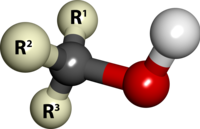
Photo from wikipedia
Abstract Seven skeletal reaction mechanisms are presented to highlight key chemistry for mechanism reduction of small alcohol fuels at engine conditions. The mechanisms predict ignition delay times, laminar burning velocity,… Click to show full abstract
Abstract Seven skeletal reaction mechanisms are presented to highlight key chemistry for mechanism reduction of small alcohol fuels at engine conditions. The mechanisms predict ignition delay times, laminar burning velocity, and extinction strain rate, within 5% of their corresponding complex mechanisms used as a start point for reduction. The mechanisms were developed for equivalence ratio range of 0.7–1.4, pressure range of 1–40 atm, and low to high temperature ignition (700–1700 K), using air mixed with methanol, ethanol, or n-propanol The study points out the importance of tailoring the reduced mechanism to the target computational fluid dynamic simulation case. Moreover, important reaction pathways when constructing LES suitable mechanisms are highlighted, and a further need to study the reduced low temperature ignition chemistry in order to meet reasonable sizes for computational fluid dynamic simulations are identified.
Journal Title: Fuel
Year Published: 2020
Link to full text (if available)
Share on Social Media: Sign Up to like & get
recommendations!